Large part machining deals with extra big parts that cannot be worked easily and may include the use of heavy and sophisticated tools. This is because of issues of handling very big parts, thermal expansion, and dimensional accuracy over a very large area.
In this article, we will take your through a detailed process how to machine large parts. From handling the most challenging designs, handling sizes to producing the best part finishing.
Let’s dive right in:
Challenges in Machining Large Parts
Working large components that require large-format machining presents its own problems. When you are deploying changes to your working methods, be sure to mind these seven key challenges:
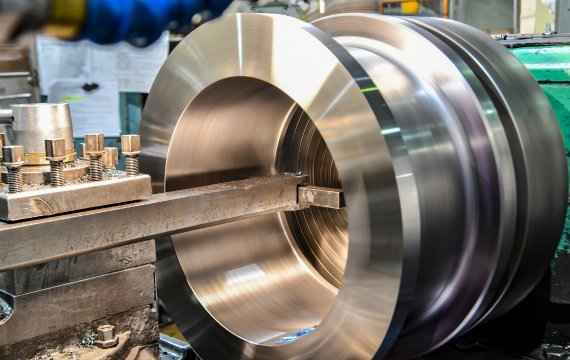
· Material Handling Difficulties
When dealing with large parts you will necessitate equipment that will help transport and orient them appropriately. Make sure your setup of your project will be able to handle the weight and size in the process of fabrication.
· Thermal Expansion and Distortion
Sections are liable to dimensional changes due to thermal expansion of large parts. You will also have to ensure that temperatures are carefully moderated and managed to ensure the position of the instrument is accurate.
· Preservation of correct Records over an Extended Range
Maintaining precision around large parts is not straightforward. If you design carefully and use up-to-date measuring gauges and instruments, you can keep tolerances close.
· Vibration and Stability Issues
Get ready for more vibration when using larger parts. Of course, you will have to count on small fixturing and a stable machine condition to reduce the surface defects and increase the tool’s durability.
· Tool Wear and Machining Time
Long machining times most of the time are likely to be detrimental to your tools. Best of all is to maintain an optimal balance in terms of tool usage. This is to ensure that a set of standards is achieved without costing a lot of money to meet it.
· Custom Fixturing Requirements
Big sections can require additional fixtures of a particular kind. It is important to make some sureties that your fixturing is well-fixed and well-suited for holding the part in place throughout the process.
· Difficult Control of Inspection and Quality
The inspection of large parts is often not easy. You will require specific instruments and strategies to perform checks to guarantee every dimension complies with the stipulated standards.
Types of Machines Used for Large Part Machining
These types are as follows take a look:
Gantry Mills
With extra-large pieces, particularly ones with massive weight, gantry mills are your best bet. They offer good accuracy over large areas due to their very robust construction and ample table surface.
Vertical Boring Mills
If you need to machine large cylindrical parts then vertical boring mills are just perfect. They enable you to directly machine heavy, oversized parts accurately especially when it comes to deep holes and complex shapes.
Horizontal Boring Mills
Another type of special-purpose machine is the horizontal boring mill. This is ideal for use in machining large, heavy workpieces with long extensions. It is used for boring, milling, and drilling operations and provides accuracy irrespective of the distance in between.
Large CNC Lathes
In case of turning over-sized parts, large CNC turning machines are inevitable. They let you hold different dimensions and the surface finish of a part to high standards. This allows you to accommodate large supply parts.
CNC Drilling Machines
When it comes to larger parts and the need to have a very high accuracy in terms of hole-making, then CNC drilling machines cannot be overlooked. What they offer you is the ability to drill complex patterns and depths as per the requirement of your project.
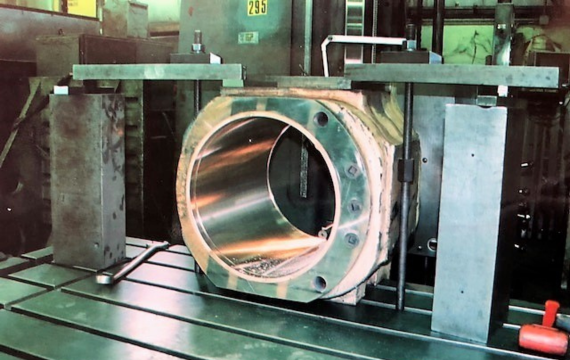
Electrical Discharge CNC machines (EDM)
For any material that is hard or shape complex, then the EDM machines will prove useful. They employ the utilization of electrical discharges to form metal which makes them suitable for geometries in massive sections.
Planer Mills
For roughing and removing a great deal of material relative to large workpieces, planer mills are the way to go. They’re ideal for machining flat or even inclined planes in the required degree of precision for large-scale projects.
Common Materials Machined in Large Part Machining
Below are some of the options of materials most often machined in large part machining:
- Steel: Machining large parts, steel is probably a material you encounter rather often. It is strong, and rigid, and is applied in numerous applications including construction, automotive, and the manufacturing of heavy machinery.
- Aluminum: Aluminum is for you if what you are looking for is a material that is light but very strong and rigid. It is most suitable for the aerospace as well as the automotive industry where a loss of weight is crucial but not strength.
- Titanium: In cases where you need a material that has a relatively high-strength-to-weight ratio and you want to avoid corrosion then titanium serves the purpose very well. It is commonly used in aerospace, medical, and marine industries, but it is highly reactive hence should be handled carefully.
- Stainless Steel: Stainless steel is somewhat special when it comes to corrosion protection is required. It can be used in any application where cleanliness is important such as food processing machines, and service equipment, medical equipment among others.
- Cast Iron: For apps in which wear resistance and dampening of vibrations are required cast iron is quite suitable. Rich in application, it is widely used in large machinery bases, engine blocks, and other structural partsnecessitating high stability.
- Composites:Lightweight materials bonded with strength, especially in aircraft and car industries are transitional materials such as carbon fiber composites. They have good strength-to-weight proportions but can only be processed using special procedures.
- Brass and Copper: Copper and brass are the materials mostly used in machining for electrical uses, plumbing, and rather ornamental pieces. These are easy to machine, enhance current conductivity, and do not corrode easily.
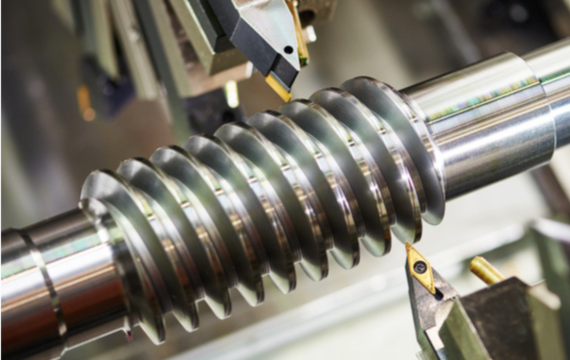
Machining Techniques for Large Parts
These techniques are as follows. Take a look:
1. CNC Machining
CNC Machining is your primary method of achieving accuracy in large parts. This one lets you enter more elaborate sets of instructions so that precision is maintained across wide ranges of dimensions. It is used in milling, drilling, and turning operations.
2. Deep Hole Drilling
In order for deep holes that penetrate the large workpieces in one pass to be produced, particular methods of deep hole drilling are required. This is done by utilizing special gadgets that help in evacuating the chips and also maintaining straightness over long distances.
3. High-Speed Machining
When time is a factor that cannot be compromised, high-speed machining assists in the removal of material at a faster rate while observing accuracy.Which is key when it comes to large workpieces.
4. Adaptive Machining
Adaptive machining enables real-time response to some material conditions or geometrical deviation in the process assuring the right accuracy regardless of the hurdle.
5. Surface Grinding
The surface grinding is applied to those parts that need to have tight tolerance and fine surface finishing especially on large pieces. It is very useful in the last operations where a high surface finish is desirable or necessary.
6. Broaching
Keywaying or broaching is an extremely efficient method of cutting gears or parts of a specific form in large stocks. It is most advantageous for your application if you wish to shave in one cycle leaving a neat and uniform ridge across the material.
7. Milling
- Climb Milling: This is a very useful method when it is necessary to reduce the degree of tool wearing and enhance the surface quality. In this approach of cutting, you decrease heat build-up and tool deflection which is especially important for large parts.
- Heavy-Duty Milling: When a large section of material has to be cut off, there is a need to undertake heavy-duty milling. These machines are capable to endure the pressures of machining difficult materials.
8. Surface Finishing Techniques
Final operations like honing, polishing, lapping, or additional grinding will give the end surface finish required. They enhance both the aesthetic value and operation efficiency of your large parts.
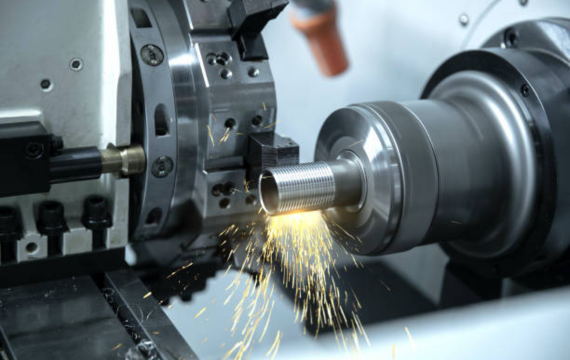
Difference Between Standard Machining and Large Part Machining
When you move to large part machining, you’ll find it’s quite different from standard machining in scale, precision, and equipment requirements, as follows.
Scale of Operations
- Standard Machining: You work with smaller forms, which facilitate setting up and also ensure faster working of the part.
- Large Part Machining: Here, you work with much bigger parts, these necessitate the use of specific tools and normally involve more time.
Machine Capabilities
- Standard Machining: Here your machines are small, built for fine work, and fast, high revolutions per minute.
- Large Part Machining: The work requires highly sturdy and stable machines capable of carrying loads and offering high accuracy over a wide area.
Material Handling
- Standard Machining: It is easy to handle the material with small parts hence there will be faster cycles.
- Large Part Machining: They involve the use of cranes, large fixtures, and custom jigs because some of the part sizes require handling through these tools.
Precision and Tolerances
- Standard Machining: It is possible to attain tight tolerances because the size of the parts is small and therefore easy to regulate.
- Large Part Machining: There are more difficulties in maintaining precision because the scale is greater; it is necessary to spend more time on planning and using various techniques.
Tooling
- Standard Machining: Here you employ as smaller and more accurate cutting tools, specialized to perform delicate operations.
- Large Part Machining: For example for big parts, your tooling requirements are larger and stronger for the stresses that are endured during machining.
Setup and Operation Time
- Standard Machining: Setups are fast and the operations are even faster.
- Large Part Machining: Setups are longer and the overall machining is a longer process.
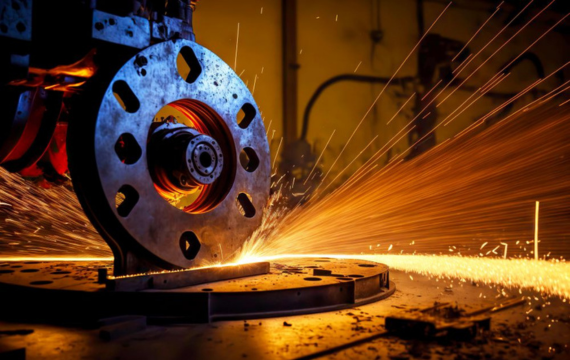
Considerations & Tips for Machining Large Parts
By endeavoring to follow these guidelines, you will be able to machine large parts in a manner that achieves your required accuracy in conjunction with great productivity:
- Machine Rigidity
Make sure that your machine can take the weight and size of the large parts that it will handle most of the time. This also aids you in maintaining more accurate work and avoids the possibility of tool deflection.
- Proper Fixturing
Before the machining process begins, be sure to clamp your workpiece down well, to prevent movement during the process. This is to ensure accuracy, especially with large parts that may result in misalignment once a wrong fixturing technique is used.
- Material Handling
Employ big fixtures, cranes, or even custom jigs to lift your workpiece with a view to handling it in a stable manner. Proper handling of materials ensures time is saved and minimizes mistakes that might occur along the process.
- Tool Selection
It is wise to select tools that are strong and made for highly demanding machining applications. What is essential for you is to select equipment that will be capable of handling the forces required to metallurgically cut large pieces.
- Thermal Management
Be careful of heat checking which causes distortion of large parts. Choose all the coolants and proper machining strategies in a way that you deal effectively with heat.
- Inspection and Measurement
Constantly check and compare the utilization of your workpiece over the different phases of machining. This way, any errors that you make are noticed and corrected before and the necessary tolerances are kept.
How Large Part Machining is Different
Keeping the following differences in mind helps you manage large part machining efficiently:
- Accuracy: It is even harder to maintain the size of an extra-large part accurately. The accuracy of the measurements is affected by the fact that the larger the part the more difficult it is to achieve accuracy. Remember to be as accurate as possible; employ sophisticated tools and methods in order to do so.
- Stress: Larger parts put more force on your equipment and implements. More weight and size increase the chances of wear of the same. Make sure your tools and machines and all those equipment are strong enough to stand the pressure.
- Tooling: The tooling for large parts is required to be more robust and quite often much larger as well. Sometimes, in order to do heavy work, you cannot use regular tools, you have to use more robust specific ones.
- Tolerance: It is even more complicated to achieve tight tolerances in big parts. It is, however, much more challenging to maintain consistency over larger surfaces. A lot of attention should be paid to the question of checking and the use of precise methods.
Conclusion
With large part machining, pay attention to precision, sturdy machinery, and effective handling techniques.
Once you consider all the points in this guide, you will easily machine large parts.
At KDM, we have experience in machining large parts, while working with our partners to help in the entire shipping process.
For any inquiries or quotation, contact KDM team now.




